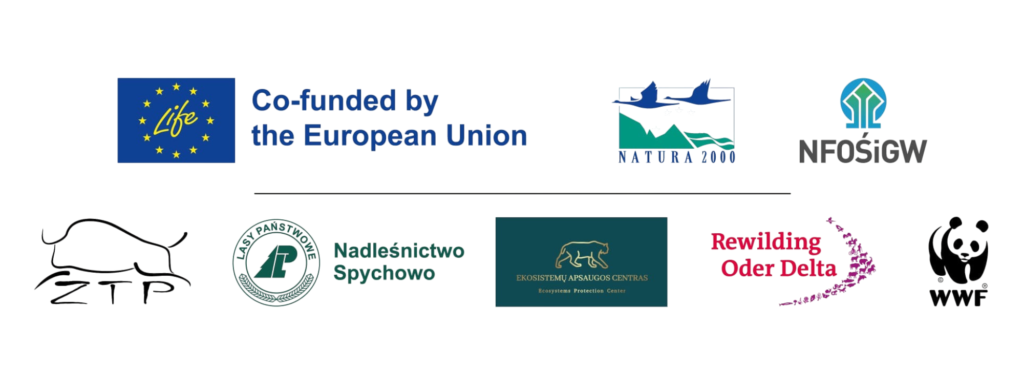
On October 3, 2025, workshops organized by the WWF Poland Foundation took place in Bielsk Podlaski, during which naturalists, representatives of state institutions, and scientists attempted to assess the conservation status of local lynx populations in the Podlaskie and Warmian-Masurian Voivodeships. The event, to which foresters, nature photographers, and representatives of the Polish Hunting Association were invited, was carried out as part of the LIFE22-NAT-PL-LIFE LYNX PL LT DE project „Expansion of the lynx population range in northern Poland”.
The workshops were held at the headquarters of the Bielsk Podlaski Forest District. They were opened by Adam Kwiatkowski, Head of the Department of Nature Resource Protection from the Regional Directorate of State Forests in Białystok, followed by Forest District Manager Marek Półtorak from the Bielsko Forest District, who spoke about the natural conditions of the areas once occupied by the Bielska Forest. The Forest District includes, among others, three nature reserves, seven Natura 2000 areas, and two protected landscape areas.

Forest District Manager Marek Półtorak during his presentation at the workshops in Bielsko Podl.
There are great hopes associated with the natural resources of the Podlaskie Voivodeship in the context of expanding the range of the lynx population in northern Poland – the flagship goal of the LIFE22-NAT-PL-LIFE LYNX PL LT DE project. Malwina Kujawa-Strejk from the West Pomeranian Nature Society (ZTP), which coordinates the project and conducts lynx reintroduction in northern Poland, spoke to the gathered audience about the formal assumptions of this undertaking, which has been ongoing since 2023. Maciej Tracz from ZTP shared his experiences related to releasing lynx into the wild, monitoring animals using telemetry collars, and rehabilitating individuals requiring treatment. The West Pomeranian Nature Society has significant experience in this area – it has reintroduced nearly 100 lynx in the forests of northwestern Poland over the past 6 years. ZTP also runs a rehabilitation center for these predators in Jabłonowo, where lynx are prepared for release into the wild after being treated, for example, for mange, a fairly common disease in these animals.

Speakers of the workshops at the Bielsko Podlaskie Forest District
Are the successful reintroduction efforts from western Poland replicable in the eastern part of our country? They are certainly needed! Dr. hab. Tomasz Borowik from the Mammal Research Institute of the Polish Academy of Sciences spoke to the audience about the condition of lynx populations in Podlasie. Unfortunately, according to research, the Podlaskie population is in deep crisis. Especially in the Knyszyńska and Augustowska Forests, the number of lynx is low. Among the unfavorable factors for lynx in this region of Poland, the scientist pointed out the low availability of lynx prey and the partial isolation of the population due to the barrier on the Polish-Belarusian border.
The currently ongoing Life project may reverse this unfavorable trend because the expansion of the lynx’s range in northern Poland is to be based on strengthening local populations, creating conditions for effective migration of individuals, and gene flow throughout the Baltic lynx population. The importance of diversity and proper genetic selection of reintroduced lynx was explained during the workshops by Prof. dr hab. Mirosław Ratkiewicz, an expert in the field of animal population genetics. According to the professor, effective gene flow between individual lynx habitats can help restore the former range of this species. For this, wise management of natural resources, including economic forests, is needed to maintain ecological continuity for the species, so that, for example, Masurian lynx can interbreed with lynx from Podlasie.
Stefan Jakimiuk, a senior species protection expert at WWF Poland, who has been involved in rebuilding the local population since 2007, spoke about the aforementioned Masurian lynx during the workshops. It is a peculiar and inspiring case because although the lynx occurring in Masuria are not numerous and it is estimated that about 30 individuals live there, their population exhibits high genetic variability, which is a chance for its growth and survival. Thanks to DNA studies, we also know that gene exchange between local lynx populations, which is an assumption of the LIFE22-NAT-PL-LIFE LYNX PL LT DE project, is already taking place in Masuria – lynx migrants from the Knyszyńska or Białowieża Forests have been identified there, and recently also from the Biebrza National Park area.
At the end of the workshops, a panel discussion took place, during which experts and invited guests engaged in a lively discussion about methods for monitoring the presence of lynx in individual forest complexes, cooperation in minimizing threats to this species, and strengthening social acceptance for the presence of lynx in the forests of northern Poland.

Discussion panel during the workshops
The Life project „Expansion of the lynx population range in northern Poland”, under which the workshops in Bielsko Podlaskie were held, is implemented with financial support from the European Union and the National Fund for Environmental Protection and Water Management. Partners in the project include: West Pomeranian Nature Society, WWF Poland Foundation, Spychowo Forest District, Association for the Protection of Ecosystems (Lithuania), Rewilding Oder Delta (Germany).




